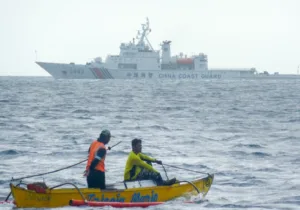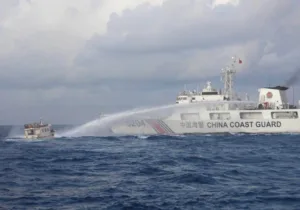After months of warnings, the White House finally ordered the Navy to sail within 12 miles of an artificial island built by China. President Obama’s hesitant response to China’s aggressive behavior suggests he doesn’t grasp that there’s nothing new about the Navy challenging this sort of mischief. America has been keeping the open seas open for 215 years.
Before digging into some of that history, we need to understand what China is doing today. China is laying claim to 90 percent of the South China Sea based on a map drawn by Chinese cartographers in 1947, flouting international norms and turning reefs hundreds of miles from its territorial waters into military outposts.
Beijing’s goal: to control the resource-rich South China Sea and muscle the United States out of the Western Pacific. Beijing’s new military strategy offers some of the details of how it will achieve this goal. The document vows to “accelerate the modernization of national defense and armed forces [and] resolutely safeguard China’s sovereignty, security and development interests.”
China is certainly succeeding at the former: China’s military spending mushroomed 170 percent between 2004 and 2013. Beijing increased military spending by 10 percent in 2015 and 12.2 percent in 2014.
As to the latter, Beijing’s notion of sovereignty differs radically from that of its neighbors. By international convention, a country’s territorial waters extend 12 miles from its coastline. Beyond that, nations observe an exclusive economic zone (EEZ), which extends 200 miles off a country’s coastline and allows for privileged exploration rights. Not only does Beijing expect others to observe its EEZ and the airspace above as sovereign Chinese territory, not only does Beijing refuse to respect the EEZs of its neighbors, but Beijing claims territories 500 miles from the Chinese mainland.
As they dot international seaspace with man-made islands, China’s leaders are taking what’s not theirs. The lesson of Munich teaches that it’s better to confront such aggression than to appease it.
That brings us to America’s enduring role in defending freedom of the seas, which dates almost to the beginning of the republic.
At the time of George Washington’s inauguration, Americans were being held hostage by Barbary pirates. The U.S. paid huge sums to win release of those being held—and appease further piracy. Thomas Jefferson opposed this policy as secretary of state, and he overturned it once he became president. He initially proposed an anti-piracy coalition with Europe “to compel the piratical states to perpetual peace.” But as the Library of Congress explains, “Jefferson’s plan for an international coalition foundered on the shoals of indifference.” (Sounds familiar.) So, Jefferson launched a war on piracy, concluding, “It will be more easy to raise ships and men to fight these pirates into reason, than money to bribe them.”
Of the hundreds of instances of U.S. military intervention tallied by Congress, dozens are related to piracy, freedom of the seas and maritime poaching. So, it’s no surprise that President Wilson’s 14 Points called for “absolute freedom of navigation upon the seas.” FDR and Churchill’s Atlantic Charter envisioned a postwar peace allowing “all men to traverse the high seas and oceans without hindrance.” FDR bluntly called “freedom of the seas” an “American policy.”
Since 1979, U.S. forces have challenged airspace and coastal claims under the Freedom of Navigation program. Thus, when Libya declared the Gulf of Sidra as its own, the Carter administration ordered U.S. warplanes and warships into the area, although it suspended the exercises during the Iranian hostage crisis. When President Reagan resumed the exercises, Qaddafi sent warplanes into international airspace to challenge the Americans. U.S. Naval airpower responded with deadly force and made it clear to Qaddafi that there would be no payoff for disregarding international norms. Reagan wasn’t finished defending freedom of the seas. When Iran attacked noncombatant shipping during the Iran-Iraq War, Reagan ordered Kuwaiti ships reflagged and had U.S. warships escort Kuwaiti vessels. After an Iranian mine ripped through a U.S. ship in international waters, Reagan launched a series of punishing military strikes against Iran’s fleet.
Today, 90 percent of global trade travels by sea. It doesn’t happen by accident or by magic. The burden of keeping the sea lanes open largely falls on the U.S. Navy, which is why the Freedom of Navigation program continues. Yet up until USS Lassen’s movement the last week of October, Washington had kept the Navy from operating near the disputed reefs claimed by China since 2012.
Looking ahead, Obama should order the Navy to enforce freedom of the seas by routinely steaming ships through international waters China is trying to poach. Recent reports that the Navy plans to conduct patrols within 12 miles of these instant islands at least twice per quarter are a positive sign. These exercises should not be pre-announced. Just as I need not notify my neighbors of where, when or why I will be traveling the city streets, Washington is under no obligation to forewarn Beijing about plans to deploy U.S. assets in international seaspace and airspace.
Second, the administration should internationalize the problem. The Association of Southeast Asian Nations has issued a declaration endorsing “freedom of navigation in, and over-flight above, the South China Sea.” Washington should put muscle behind those words by organizing a multinational maritime taskforce to challenge China. News that Australia is considering “sail-through” operations near the instant islands should be applauded.
Third, Washington should end the bipartisan gamble known as sequestration. At the height of Reagan’s buildup, the Navy boasted 594 ships. The post-Cold War Navy of the 1990s totaled 375 ships. Today’s fleet numbers just 284 ships. Combatant commanders say they need a Navy of 450 ships. Read more at The American Interest.
Alan Dowd is a contributor to the Providence journal’s daily blog.






